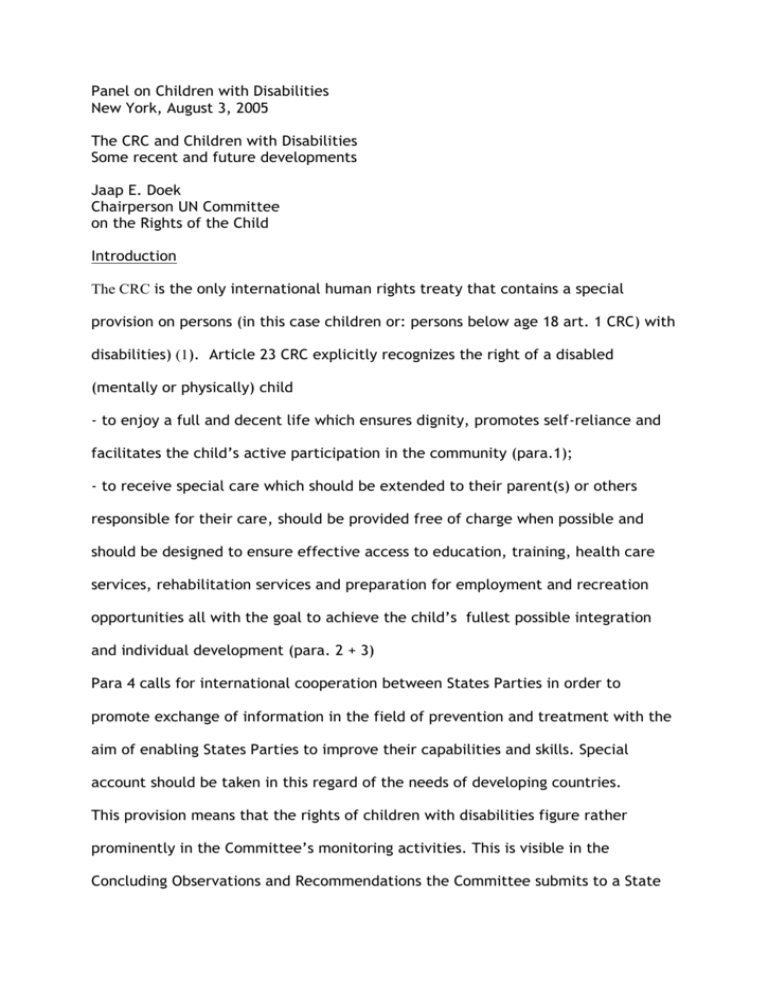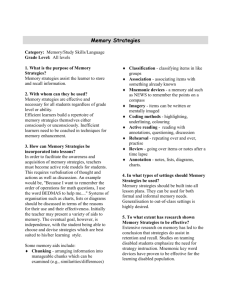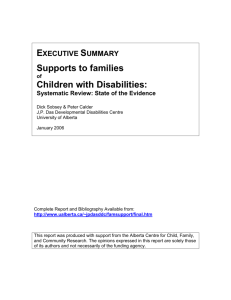ahc6side3aug1.doc
advertisement

Panel on Children with Disabilities New York, August 3, 2005 The CRC and Children with Disabilities Some recent and future developments Jaap E. Doek Chairperson UN Committee on the Rights of the Child Introduction The CRC is the only international human rights treaty that contains a special provision on persons (in this case children or: persons below age 18 art. 1 CRC) with disabilities) (1). Article 23 CRC explicitly recognizes the right of a disabled (mentally or physically) child - to enjoy a full and decent life which ensures dignity, promotes self-reliance and facilitates the child’s active participation in the community (para.1); - to receive special care which should be extended to their parent(s) or others responsible for their care, should be provided free of charge when possible and should be designed to ensure effective access to education, training, health care services, rehabilitation services and preparation for employment and recreation opportunities all with the goal to achieve the child’s fullest possible integration and individual development (para. 2 + 3) Para 4 calls for international cooperation between States Parties in order to promote exchange of information in the field of prevention and treatment with the aim of enabling States Parties to improve their capabilities and skills. Special account should be taken in this regard of the needs of developing countries. This provision means that the rights of children with disabilities figure rather prominently in the Committee’s monitoring activities. This is visible in the Concluding Observations and Recommendations the Committee submits to a State 2 Party after it has reviewed its report on the implementation of the CRC. For instance: in each of the sets of Concluding Observations issued after the most recent session (38th May (June 2005) one can find rather concrete/detailed recommendations for further strengthening the full implementation of the rights of the disabled child (countries considered at the 38th session: Bosnia/ Herzegovina, Costa Rica, Ecuador, Mongolia, Nepal, Nicaragua, Norway, Philippines, Saint Lucia and Yemen). In this short presentation I will briefly present some of the recent and future developments regarding the Committee’s monitoring of the implementation of the rights of children with disabilities and the need for improving this monitoring. Before doing that one final general observation: the importance of the CRC for children with disabilities is not limited to article 23. On the contrary: all articles of the CRC are equally important for disabled children because States Parties shall respect and ensure, as article 2 CRC clearly states, the rights set forth in this Convention to each child within their jurisdiction without discrimination of any kind, irrespective of the child’s (…………) disability. It should be noted that the CRC is again unique because it is the only international HR treaty which in the nondiscrimination article explicitly mentions “disability” as an unacceptable ground for discrimination (compare e.g. Art. 2 ICCPR and art. 2 ISESCR) (3) It means that the Committee’s observations regarding the implementation of the rights of the children with disabilities are not limited to article 23. One can find them in relation to many other articles of the CRC in particular in relation to article 2 but also in relation to general measures of implementation (like: data collection, need for comprehensive policy, training of professionals), the right to education (art. 28), the right to health care (art. 24), the right to family life and alternative care 3 (art. 20) and protection against violence (art. 19) (2) In order to promote the implementation of the rights of children with disabilities the CRC Committee has (in addition to its systematic attention given to this matter in the Concluding Observations) undertaken the following actions (due to time constraints just a summary) - A Day of General Discussion in 1997 on the rights of the children with disabilities resulting in 14 recommendations for future action. These recommendations have been the guidance for the Committee’s work over the past years; - the establishment (as a follow-up to the 1997 Day of Discussion) of the NGO Rights for Disabled Children (RDC). Various (international) NGO’s for persons with disabilities and the CRC Committee were involved when it was officially established in 1999. This NGO had for about 4 years an important input in the monitoring work of the Committee by providing country specific comments, questions and recommendations regarding the rights of children with disabilities. Unfortunately, this NGO ceased to exist due to lack of funding and it should be noted that no other NGO active in the area of persons with disabilities has taken over the role of DRC. This is regrettable and may indicate that more awareness is needed concerning the importance of providing the Committee with specific information on the implementation of the rights of disabled children, information that is often lacking or (very) limited in the official States Parties Reports; - a UN Study on Violence against Children, recommended by the CRC Committee, is underway. Over the past several months regional consultations have been held allowing for input by governments, UN agencies, NGO’s and children and youth. In some of these consultations children with disabilities played a rather active role but not in all the recommendations that came out of these Consultations children 4 with disabilities were given appropriate (sufficient) attention. If one looks back over the past 10 years it is fair to conclude that the CRC, the monitoring activity of the CRC Committee and the activities of the NGO’s have contributed to an increase of awareness with respect to the rights of disabled children and to an improvement of the implementation of these rights. But it can also be concluded that there are areas/aspects of the rights of disabled children that – despite the various positive developments – need more attention. Inter alia: - birth registration. Given the low status of children with disabilities in many countries, they belong often to the group non-registered children. Meaning: they officially do not exist and are therefore even more vulnerable to exploitation, trafficking or even killings. right to life/protection against violence. Children with disabilities run the risk of not being provided with life saving treatment. Killing of children with disabilities by parents or other caretakers is often met with very lenient (non-custodial) sentences if those cases are prosecuted at all. Children with disabilities are more likely to become victims of violence (sexual/physical or other abuses) and not enough information is available on effective prevention and intervention programmes (most likely because these programmes are rare). -the right to engage in play, recreational activities, cultural life and arts (art. 31 CRC). Disabled children do need extra support (facilities/opportunities) to fully enjoy this right. More attention is needed in that regard. - information and participation. Disabled children often don’t have access to information about their rights (as enshrined in the CRC) and don’t (partly as a consequence of this lack of information), participate or participate only very 5 limited (and not on an equal footing) in the decisions that affect them. All this confirms the need – already expressed in the 1997 Recommendations – of a General Comment in which the Committee can present a comprehensive picture of the rights of children with disabilities. 3. Future developments/CRC and the new Convention Currently and in line with the conclusions related to the recent developments, the Committee is engaged in the drafting of a General Comment on the Rights of Children with Disabilities. The purpose of this Comment is inter alia to provide the States Parties with a comprehensive set of guidelines and recommendations of the implementation of the CRC (and not only art. 23) for children with disabilities. It means for Instance that the General Comment will give attention to the need for an Infrastructure in terms of e.g. legislation, coordination of services, budget allocations, awareness and training for professionals which is supportive and conducive for the implementation of the rights of disabled children. It will furthermore elaborate on basic principles and rights such as the best interests of the disabled child (art. 3), the right to non-discrimination, the right to life, survival and development (art. 6), the right to express her/his views, to be heard and have her/his views taken into account (art. 12. Finally, the General Comment will present more specific information and guidance on the meaning of the other rights in the CRC for children with disabilities and how they should be implemented taking into account the special needs of these children. The Committee intends to discuss a first elaborated outline of this General Comment at its next session in September 2005. Further development of this 6 document will be based on input form all interested NGO’s, UN agencies and individuals in an open consultative process. When approved by the Committee (next year) the General Comment should be the key tool for the promotion and implementation of the human rights of children with disabilities. But that tool needs to be used not only by the States Parties at the Committee’s recommendation, but also by UN agencies and NGO’s. In that regard the Committee really considers it to be necessary that the input from NGO’s with country specific information into its pre-sessional working group meetings will be resumed. That input, together with input from UN agencies is crucial to create and maintain the necessary momentum for an effective follow-up to the General Comment. In addition to these activities the Committee wants to underscore the need for full attention for children with disabilities in the report of the Study on Violence against children. Given their particular vulnerability and the high degree of invisibility of violence and abuse of disabled children the study should produce recommendations for concrete and, where appropriate, time bound actions for prevention and treatment of such violence and abuse. With these and other possible actions – e.g. regional follow-up to the General Comment and the recommendations from the Study on Violence the question arises what a thematic Convention on the Rights of Persons with disabilities could add to this for disabled children. Not much I am afraid if the Convention does not contain a provision which specifically deals with the special position and vulnerabilities of children with disabilities. In that regard the history of e.g. the ICCPR and the ICESCR has taught us that the lack of one or more specific provisions on children means very limited attention 7 for the implementation of the rights in those conventions for children despite the theory that all those rights are also applicable to children because children are human beings with, in principal, the same human rights as any other human being. Illustrative in this regard is that the General Comment nr. 5 on Persons with Disabilities of the CESCR (1994, Docum.E/1995/22), undoubtedly a landmark document, does pay in fact no attention to the specific position and vulnerabilities of disabled children. If the new thematic Convention wants to be a comprehensive one special attention must be given to disabled children. Don’t assume that without such a provision children will be given the attention they deserve in the process of monitoring the implementation of that new Convention. But is that special attention necessary given the existence of the CRC and in Particular art. 23 CRC? It is, if we like to strengthen the observance and Implementation of the rights of children with disabilities. - the special provision(s) could (partly) support the principles and fundamental rights of children (nothing wrong with that in a Convention on the Rights of Disabled Person) but should address some of the insufficiencies in art. 23 CRC By e.g. strengthening the obligations of States Parties to take measures specifically focussing on the implementation of the rights of disabled children. Keep in mind that the General Comment despite its potential impact is not a legally binding Instrument; - the monitoring activities of the CRC Committee and the Committee under the new Convention could be, via good coordination, mutually supportive and result most likely in a more frequent assessment of the progress made than currently is possible under the 5 year reporting frequency of the CRC. 8 In conclusion: the CRC Committee continues and strengthens its efforts to promote the full implementation of the CRC for all children with disabilities. It can only succeed if States Parties are willing to meet their obligations where appropriate with the support of UN agencies and NGO’s. The new Convention can be an important addition to the instruments for the promotion and effective implementation of the human rights of disabled persons and in particular for children with disabilities. Notes 1. There are regional Human Rights instruments that (also) contain special provision: - Art. 18 of the Additional Protocol to the American Convention on Human Rights (Protocol of San Salvador 1988) on the Protection of Handicapped (nothing specific on children); - Art. 18, para 4 of the African Charter on the Human and People’s Rights limited to: aged and disabled have the right to protection; - Art. 13 of the African Charter on the Rights and Welfare of Children with provisions more or less similar to art. 23 CRC. 2. See for an overview of recommendations on various aspects (and not limited to art. 23 CRC) of the implementation of the rights of children with disabilities: Report of the NGO Rights for disabled Children: a Review of the Committee’s Recommendations in respect of disabled children in the period 2001-2003). 3. Regional HR treaties also make no explicit reference to “disability” in the provision on non-discrimination not even in the African Charter on the Rights of Welfare of Children (see art. 3).







